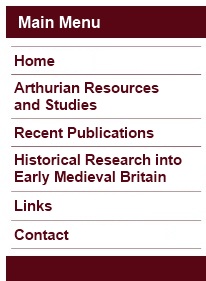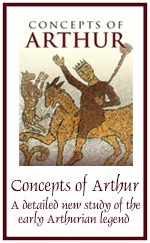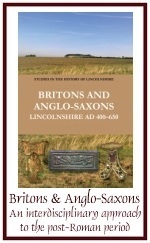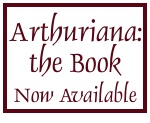
 |
 |
A
Guide to Arthurian Archaeology: Badon, Castle Killibury, Glastonbury,
South Cadbury & Tintagel
A brief guide to the various locations which have been connected with the pre-Galfridian Arthurian legend is offered below. The first version of this guide appeared online in 1998; an up-to-date discussion of Badon and its attribution to Arthur can be found in my Concepts of Arthur, chapters one and six. The notes on the other locations will continue to be archived at this website in their existing form. Although they are in need of some revision, particularly to take full account of recent excavations, it is hoped that they nonetheless continue to provide a useful discussion of the Arthurian associations of these sites. Duodecimum fuit bellum in monte Badonis 'The twelfth battle was on Badon hill' (Historia Brittonum, chapter 56). The battle of Badon is probably the most famous of Arthur's alleged battles, largely because it is also recorded by Gildas in his De Excidio Britanniae §26.1 (obsessio Badonici montis), where it is described as the culmination of the British counter-attack against the Saxons, thus making its historicity certain. The battle is undated in the Historia Brittonum and the date that Gildas gives to this event is obscure also, depending to a great extent upon the dating of Gildas' text, though somewhere around A.D. 500 is generally agreed to be likely (the evidence of the mid-10th-century Annales Cambriae is of no real value in determining the date of the battle, for the reasons discussed in T. Green, Concepts of Arthur (Stroud, 2007), chapter one, and 'The Historicity and Historicisation of Arthur'). Before going any further it must be pointed out that the association of this battle with Arthur can be evidenced no earlier than the 9th century, with recent research into the earliest manuscript of Gildas' DEB (British Library, Cotton Vitellius A.vi) concluding that, rather than not identifying the battle with any particular British leader, Gildas in fact identifies the victor of Badon as Ambrosius Aurelianus (O. J. Padel, 'The Nature of Arthur', Cambrian Medieval Celtic Studies, 27 (1994), pp. 1-31 at pp. 16-18; M. Wood, In Search of England: Journeys Into the English Past (London, 1999), pp. 34-38). This confusion over the victor fits into the picture described elsewhere of a process by which a non-historical folkloric figure named 'Arthur' was historicised, partly with great battles from the past fought by genuine leaders of the 'Heroic Age' (see Green, 2007, chapter six; Padel, 1994). This does not, of course, lessen the desire to identify the site of this battle, and this question has long been a source of controversy. One possible location for Badon might be at one of the many 'Badburys', as these place-names may derive from Badon plus Old English byrig/burh, 'fortification, fortified place' (see M. Gelling, 'Towards a chronology for English place-names', in D. Hooke (ed.) Anglo-Saxon Settlements (Oxford, 1988), pp. 59-76 at pp. 60-61; K.H. Jackson, 'The site of Mount Badon', Journal of Celtic Studies, 2.2 (1958), pp. 152-55). Another possible location is Bath, if this was earlier known as Badon (see T. Burkitt and A. Burkitt, 'The frontier zone and the siege of Mount Badon: a review of the evidence for their location', Proceedings of the Somerset Archaeological and Natural History Society, 134 (1990), pp. 81-93; L. Alcock Arthur's Britain (Harmonsworth, 1971)). The problem is that the philological arguments can take us no further than this -- one can accept a British origin for the name of Bath or one for the name Badbury, but it is a subjective judgement with nothing to argue conclusively for either side. Indeed, if the Badbury suggestion is adopted, then there is the further problem of 'which Badbury was Badon?', as there are many Badburys and related names located across southern Britain from Dorset through to Lincolnshire. Unfortunately the other available evidence for the location of Badon (both historical and archaeological) is similarly subjective and inconclusive (see S. Hirst and P. Rahtz, 'Liddington Castle and the Battle of Badon: Excavation and Research 1976', The Archaeological Journal, 153 (1996), pp. 1-59 at pp. 8-19 for a good summary of the 'search' for Badon). Overall, the weight of archaeological evidence points to somewhere in southern or eastern Britain as the area where such a battle is likely to have been fought -- as this is where the Anglo-Saxons were in the fifth and earlier sixth centuries -- but beyond this it is difficult to progress. There is simply insufficient evidence to allow us to decide between the competing cases: 'the site of Mons Badonicus in the absence of any early topographical information... remains anyone's guess' (J. N. L. Myres, in The Antiquaries Journal, 25 (1945), p. 84). Castle Killibury, Cornwall The Arthurian associations of Castle Killibury stem from attempts to discover the location of Kelli wic, the name given in both Culhwch ac Olwen and Trioedd Ynys Prydein to Arthur's residence in Cornwall. In 1900 Castle Killibury was suggested as Kelli wic for three main reasons: firstly that a hill-fort would be the most appropriate identification; secondly that the names Kelli wic and Killibury are similar; and thirdly because it was near Tregeare Rounds. This last argument is the one that tipped the balance in favour of this site, when the name alone gave it no better case to be Kelli wic than, say, Callington and Calliwith. This argument is, however, false. Its origins lie in attempts to discover the Dimilioc that Geoffrey of Monmouth has Gorlois, Duke of Cornwall, being besieged at whilst Uther was fathering Arthur at Tintagel. Geoffrey's Dimilioc is obviously the hill-fort close by Domellick, but eighteenth-century antiquarians, reading Geoffrey's text, believed that Dimilioc had to be within a night's ride of Tintagel (Domellick is twenty miles away), though Geoffrey never states this. They thus looked for a hill-fort near Tintagel which might be Dimilioc instead, and they settled on Tregeare Rounds, leading to the invalid argument -- which seemed cogent at the time -- that Killibury was near to Tregeare Rounds and was thus likely to be Kelli wic. However, 'in the light of the re-identification of Dimilioc, there is now no reason for maintaining the suggestion [that Killibury = Kelli wic], other than the vague similarity of the names' (O. J. Padel, 'Some south-western sites with Arthurian associations', in R. Bromwich et al (edd.) The Arthur of the Welsh. The Arthurian Legend in Medieval Welsh Literature (Cardiff, 1991), pp. 229-48 at p. 236). The question thus becomes, where was Kelli wic if it was not Castle Killibury? Given the testimony of Culhwch ac Olwen and Trioedd Ynys Prydein, it seems clear that the early medieval Welsh considered it to have been located in the Cornwall or the south-west. There is some additional evidence which may help in the attempt to further narrow down the area meant, such as the reference in 1302 to a Thomas de Kellewik from the far west of Cornwall, but beyond this it is difficult to say. It is, however, worth pointing out that the name Kelli wic itself would seem to mean 'forest grove', and there is thus no pressing reason to believe that Arthur's Kelli wic was based on any real place. Indeed, as Ford points out, it may have originally been envisaged as somewhere Otherworldly (sacred groves being common in Celtic myth) and only later might a specific location have been ascribed to it (see O. J. Padel, 'The Nature of Arthur', Cambrian Medieval Celtic Studies, 27 (1994), pp. 1-31 at pp. 12-13; P. K. Ford, 'On the Significance of Some Arthurian Names in Welsh', Bulletin of the Board of Celtic Studies, 30 (1983), pp. 268-73). Glastonbury, Somerset There are two areas of interest in Glastonbury, namely the Abbey (ST 500388) and the Tor (ST 512386). Ralegh Radford's excavations at the Abbey in the 1960s aimed to discover the earliest religious activity on the site, and they uncovered an ancient cemetery of stone-lined graves near traces of a small timber structure thought to be the original church of St Mary (C. A. Ralegh Radford, 'Glastonbury Abbey', in G. Ashe (ed.) The Quest for Arthur's Britain (London, 1971), pp. 97-110). Along with this building were found post-holes interpreted as traces of wattled oratories and all of this was bounded on the east by a great bank and ditch interpreted as a monastic vallum. While there was no dating evidence these features, all lay below later Anglo-Saxon features and thus it seemed likely that they were 'Celtic' in date. More recent excavations on the precinct ditch uncovered wooden stakes which yielded radiocarbon dates centred on the late sixth and seventh centuries. Also found in this area was an eastern Mediterranean copper censer, again of late sixth- or seventh-century date, which has been taken to suggest that Glastonbury was a British Christian site which maintained Byzantine ecclesiastical contacts (C. Snyder, 'A Gazetteer of Sub-Roman Britain (AD 400-600): The British sites', Internet Archaeology, 3 (1997)). Philip Rahtz's excavations on the Tor have uncovered much more evidence of post-Roman activity (dating from the late fifth century onwards -- there is no sign of earlier activity): structures were found on the summit of the Tor and on the terrace platforms, and there were certainly wooden buildings upon these, although little remained of them. Associated with these buildings were charcoal, burnt stones and large quantities of food remains, mainly animal bones. These were not the remains of animals slaughtered on the spot, but rather of meat brought to the Tor as joints (P. Rahtz, 'Glastonbury Tor', in G. Ashe (ed.) The Quest for Arthur's Britain (London, 1971), pp. 111-22 at p. 116). Several post-holes around an eastern hollow have been interpreted as some sort of fence or protective barrier, and in the the hollow there was a variety of evidence, including an iron lamp-holder, suggestive of the presence of a building. Also found in this area was a mysterious stone cairn which defies solid interpretation but might be seen as building foundations, a bench or even an alter. The most important area was the south platform, an artificially cut platform which has been partly destroyed by erosion, where traces of a large timber building were found along with two hearths, crucibles and other evidence of metal working; a dozen pieces of imported post-Roman Mediterranean amphorae (providing dating evidence); and a carved bronze head (stylistically 'Celtic') which may have been enameled. The exact nature of the post-Roman activity on the Tor is, however, difficult to assess. The excavator favoured the explanation of the Tor as a secular fortress of a lesser British chieftain (he ruled out the idea that the Tor may have been a signalling station as part of a defensive network), due to the large numbers of animal bones, the evidence for metal-working and the presence of imported Mediterranean pottery. However, the Tor could just as easily have been a ecclesiastical site -- the main argument against this was that the large numbers of animal bones were contrary to the ascetic lifestyle of monks of this period, but recent excavations at monastic centres such as Whithorn have revealed large numbers of animal bones, thus negating this argument and making the interpretation of the Tor as an early hermitic monastic site equally as valid as the interpretation of this site as a secular fortification (see further P. Rahtz, English Heritage Book of Glastonbury (London, 1993); C. Snyder, 'A Gazetteer of Sub-Roman Britain (AD 400-600): The British sites', Internet Archaeology, 3 (1997); P. Hill, Whithorn and St Ninian. The Excavation of a Monastic Town 1984-91 (Stroud, 1997)). What then of the Arthurian associations? Arthur's connection with Glastonbury is first recorded in the Vita Gildae ('Life of St Gildas') by Caradoc of Llancarfan, which was written in the 1120s or 1130s:
This story, despite its obvious aim of justifying the privileges of Glastonbury Abbey, would appear to have ancient origins, as it is referred to in a number of other sources. However, Glastonbury was probably not part of the original tale which, it has been convincingly argued, was a story about the rescue of Gwenhwyfar from an Otherworld 'Island of Glass' similar to Preideu Annwfyn and its analogues. The version presented in Vita Gildae was probably an adaptation of this story, with the 'Isle of Glass' being identified spuriously as Glastonbury by Caradoc (the name actually means 'island, or fortress, of the Glastings', though he may not have been the first to make the identification) thus allowing him to introduce the abbot of Glastonbury -- the Glastonbury community being the recipients of his Life -- as peace-maker and beneficiary of 'many lands' from Arthur and Melwas (see P. Sims-Williams, 'The Early Welsh Arthurian Poems', in R. Bromwich et al (edd.) The Arthur of the Welsh: The Arthurian Legend in Medieval Welsh Literature (Cardiff 1991), pp. 33-71 at pp. 58-61). A far more significant Arthurian connection emerged in the 1190s, with the excavation at the Abbey of a grave containing a lead cross which proclaimed that the monks had found the burial-place of Arthur. This episode has been much discussed but it is now generally held to be a late twelfth-century fraud on the part of the Glastonbury monks, possibly for the benefit of the king rather than themselves. The case against a fraud is mainly based upon the researches of C. A. Ralegh Radford (in G. Ashe (ed.), The Quest for Arthur's Britain (London, 1971)), who demonstrated that the monks did indeed 'find' a grave and who believed that the Latin of the cross was earlier than the twelfth century, which would indicate that there was no late twelfth-century fraud. This latter suggestion has, however, now been widely rejected, and the cross is seen instead as solidly twelfth century in origins; indeed, it has been noted that the inscription derives in part from Geoffrey of Monmouth's Historia Regum Britanniae, a copy of which was present at Glastonbury from the 1170s. As such, the fact that the monks did find a grave only indicates that they chose a spot to excavate which they knew to contain an ancient grave, and the spot in question does appear to have been marked in the graveyard as such previous to their excavations. It might, of course, be proposed that while the cross is a product of the twelfth-century fraud, it was based on a genuine remembrance of Arthur being buried in the Abbey graveyard, but this can be nothing more than wishful thinking. It is worth pointing out that, previous to the 'discovery' of Arthur's 'grave', it appears to have been generally held that no-one knew where Arthur's grave was and, moreover, that he might still be alive: see T. Green, Concepts of Arthur (Stroud, 2007), chapter two, and O. J. Padel, 'The Nature of Arthur', Cambrian Medieval Celtic Studies, 27 (1994), pp. 1-31 at pp. 8-12, for a full discussion of the belief that Arthur was not dead and would return. In consequence, it seems clear that there is no reason to think that anyone did actually believe that Arthur was buried at Glastonbury before the 1190s, and the 'discovery' of Arthur's grave is thus almost certainly a monastic fraud of the type with which historians are familiar -- truly 'early' Arthurian associations at Glastonbury are only to be found in Caradoc's account, for what this is worth. See further P. Rahtz, English Heritage Book of Glastonbury (London, 1993); J. Carey, 'The Finding of Arthur's Grave: A Story from Clonmacnoise?', in J. Carey et al (edd.) Ildánach Ildírech. A Festschrift for Proinsias Mac Cana (Andover & Aberystwyth, 1999), pp. 1-14; J. P. Carley, ‘Arthur in English History', in W. R. J. Barron (ed.) The Arthur of the English (Cardiff, 1999), pp. 47-57; A. Gransden, 'The Growth of Glastonbury Traditions and Legends in the Twelfth Century', Journal of Ecclesiastical History, 27 (1976), pp. 337-58; and Somerset and Dorset Notes & Queries for 1984 for discussion of this burial and its status as a fraud. South Cadbury, Somerset This important Iron-Age hill-fort (ST 628252) was reoccupied and refortified in the late fifth or sixth century, but occupation ceased in the seventh century. The hill-fort itself is enormous and it has been estimated that around 870 men would have been needed to defend it. The nature of the evidence for post-Roman activity consists of a massive re-fortification of the defences, including a timber gate-tower (this re-fortification would have represented a formidable undertaking -- it spans 1.2 km -- and could only have been carried out by someone in command of extensive resources); post-built timber structures in the interior of the hillfort, one of which is 19 metres long by 10 metres wide and is interpreted as a feasting hall, perhaps modelled on the villa complexes of Late Roman Britain; and a large quantity of imported post-Roman Mediterranean pottery, which is associated with both the buildings and the fortifications. The scale of the occupation and the large amounts of imported pottery make it clear that this was a very high-status site, and the excavator (Leslie Alcock) would see it as an administrative centre of a large British territory. The nature of the Arthurian connection of this site is difficult to assess. The first reference to such a connection occurs in the sixteenth century, when John Leland -- a noted apologist for a historical Arthur, writing c. 1540 -- wrote that:
Although another sixteenth-century source is suggestive of a tradition that Arthur was asleep under South Cadbury hill-fort, these are very late traditions indeed, from a period in which many sites in both England and Wales were claiming a link with Arthur. As such, whilst this site was undoubtedly very important in the post-Roman period, there seems no good reason to think that these Arthurian associations are of much greater antiquity than the sixteenth century, in the absence of evidence to the contrary.* For the site and traditions see L. Alcock, 'By South Cadbury is that Camelot...', The Excavation of Cadbury Castle 1966-1970 (London, 1972); L. Alcock, 'Cadbury-Camelot: a Fifteen-year Perspective', Proceedings of the British Academy, 68 (1982) pp. 355-88; O. J. Padel, 'Some south-western sites with Arthurian associations', in R. Bromwich et al (edd.) The Arthur of the Welsh. The Arthurian Legend in Medieval Welsh Literature (Cardiff, 1991), pp. 229-48 at pp. 238-40; and now L. Alcock, Cadbury Castle: Somerset. The Early Medieval Archaeology (Cardiff, 1995). See also 'A Gazetteer of Arthurian Onomastic and Topographic Folklore'. Tintagel, Cornwall Tintagel (SX 049891) is first associated with the Arthurian legend in Geoffrey of Monmouth's Historia Regum Britanniae (c. 1138), where it features as the site of Arthur's conception, and Geoffrey's description suggests that he had seen the place himself. Whilst there is no evidence for pre-Roman occupation of the site, there is reason to believe that Tintagel was a reasonably important place in the Roman period. Two inscribed Roman milestones have been found in the Tintagel neighbourhood and it seems likely that they represent a late Roman (trading?) route passing near Tintagel. In addition Charles Thomas has suggested that Tintagel was the *Durocornovio ('Fort of the Cornovii') of the Ravenna Cosmography, something which may be supported by finds of Roman coins (from Tetricus I (270-73) to Constantius II (337-61)) and both commercial and locally made pottery of the third and fourth centuries. The exact nature of Late Roman Tintagel is, nevertheless, elusive and the main focus of activity for this site was in the centuries after the Romans left. Since the major excavations of the 1930s opinions as to the function of post-Roman Tintagel have altered considerably. The original excavator, C. A. Ralegh Radford, claimed that the site was an early Christian monastery from the fifth through to the eighth century. This interpretation has, however, been shown to be incorrect, and as a result a new historical explanation for the site is required: Tintagel is now usually seen as a very important fifth- to seventh-century secular site (a fortress or royal seat) belonging to the post-Roman kings of Dumnonia. The occupation of this site is likely to have been only seasonal given the inhospitable climate in winter months, but this fits in very well with what we know of early medieval kingship -- this was itinerant and worked on the theory that it was easier to take the large royal household to the food than it was to maintain them in one permanent location (see T. Charles-Edwards, 'Early Medieval Kingships in the British Isles', in S. Basset (ed.) The Origins of Anglo-Saxon Kingdoms (London, 1989), pp. 28-39). As such, Tintagel was probably visited by the post-Roman kings of Dumnonia to receive tribute and possibly also for the investiture of a new king: 'King Arthur's Footprint', an island-top feature, may have been the site for such a ceremony. Moreover, analysis suggests that Tintagel was the leading centre in Cornwall for trade with the eastern Mediterranean merchants, receiving tin from many places in Cornwall as 'tribute', with this then being traded for luxury goods -- including, perhaps, fine silks and other such items which are archaeologically invisible -- which were in turn redistributed outwards, via gifting by the rulers, to favoured subjects (see C. Thomas, Tintagel: Arthur and Archaeology (London, 1993)). Given this, it seems possible that, when Tintagel -- Cornish *din, 'fort' (variant *tin), plus *tagell, 'constriction', that is 'the fort of the narrow neck' -- is referred to as a royal residence or defensive site in medieval literature (King Mark's in the Tristan legends; Gorlois' in the Historia Regum Britanniae), this represents a much-distorted 'folk-memory' of historical fact. After Geoffrey's Historia, Tintagel plays very little part in the Arthurian cycle and the earliest evidence of the site being locally known as 'King Arthur's Castle' dates from 1650 -- indeed, it is usually seen in the medieval literature as the castle of King Mark, a king of Dumnonia, and Geoffrey only places Arthur's conception here, making it clear that Tintagel was the property of a local ruler (Gorlois). It is thus probable that the Arthurian associations are 12th century in origin and result from Geoffrey attaching Arthur to pre-existing folkloric material which associated Tintagel with the post-Roman rulers of the region. See further Charles Thomas, Tintagel: Arthur and Archaeology (London, 1993), for a full discussion of the site and its Arthurian connections; it should be noted that the sixth-century inscribed stone which has recently been found at Tintagel has nothing to do with King Arthur, despite media speculation to the contrary (see 'The Historicity and Historicisation of Arthur', note two). * * * * * Copyright © 1998, 2009 Caitlin R. Green. All Rights Reserved. Originally published under a former nom de plume, T. Green. To cite articles or pages from this website, use a service such as WebCite or alternatively see one of the following style citation guides. Comments and queries via email to Caitlin R. Green. |
   |